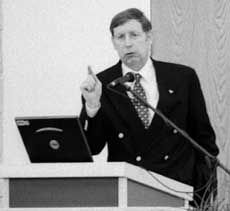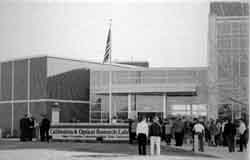New lab opens on Innovation Campus
The Space Dynamics Laboratory (SDL) of Utah State University’s Research Foundation officially opened the doors to the new Calibration and Optical Research Lab on Friday afternoon.
The CEO of the USU Research Foundation, David Norton, said the building is a “one-of-a-kind, beautiful facility.”
The 43,000-square-foot building is the fifth used by SDL. Norton said the lab is going to be used to fine-tune instruments for clients like NASA and the U.S. Department of Defense. The lab is located at Research Park, a group of North Logan buildings, where the majority of long-term USU research is conducted. It is a part of Innovation Campus, USU’s research Extension and the idea surrounding Research Park.
The Boeing Corporation donated one of the most important elements of the new lab, called the V2 chamber, Norton said. This infrared sensor test facility will allow for testing of different projects, such as small satellites, at temperatures as low as -320 F. The V2 cost twice as much as the rest of the facility, he said.
President Kermit L. Hall said this newest building at Research Park is not merely a building but an investment in the students, the employees and the community.
“This is a bet on the future,” he said.
So far, this investment has paid off handsomely, Hall said. SDL brings in nearly $50 million every year. The new goal is to bring in $120 million each year within the next decade, he said. To accomplish this goal, Hall said much “foresight and perspicacity” will be needed.
“Our best days are not behind us,” he said.
Four hundred students work with SDL every year. There are also 250 employees. Hall said that number would double within the next year.
For the last decade, SDL has hosted the Annual Conference on Characterization and Radiometric Calibration for Remote Sensing. That conference will now be held in the new building’s auditorium.
Retired Gen. Garry Schnelzer, chairman of SDL’s National Guidance Council, said he considers himself to be the customer of SDL’s work.
“The proof is in the pudding that these programs work,” he said. “You are interested in serving this nation and the world. You bring the big names in this business to this campus every year.”
Hall said much of SDL’s current success is because of its director, Allan Steed, who has been instrumental in making this one of the most productive research institutions in the country.
Steed said he is excited for the opportunities the new building will bring. There will be much expected from the people who work there.
“Gone are the days when pretty pictures from space were all that was required,” he said. “Major national decisions involving billions of dollars are being based on minor measurement changes in science parameters.”
Aside from the state-of-the-art V2 chamber, there is a new electromagnetic interference and electromagnetic compatibility anechoic chamber. Mark Jensen, who runs the chamber, said it is big enough to hold anything that can fit into the V2 and needs to be tested for electromagnetic interference. The chamber tests satellites for this interference so, once launched, they don’t send back misinformation. The walls and ceiling of the room are covered with specially designed foam pyramids that absorb the interference so it doesn’t reflect or refract off the walls and skew the results of tests, Jensen said. No cellular phones, television sets or radios will work in this room.
Cleanliness of testing equipment and the equipment tested is an integral part of the laboratory. SDL’s Jim Dyer demonstrated an advanced technology called carbon dioxide jet spray. Dyer showed how the spray is used to clean the nickel- and gold-plated mirrors of a satellite. The spray cleans surfaces by flushing them with a blast of tiny carbon dioxide snowflakes, he said. This kind of cleaning is done on surfaces that cannot be cleaned with detergents and water because of what the dirtied surface is made of, or because there are parts nearby which cannot get wet.
Dyer pointed out the many filters used to clean the air for the class-100 cleanroom. One cubic foot of the filtered air contains fewer than 100 particles larger than one-5,000th of an inch, Dyer said. In the air that is breathed in a normal atmosphere, Dyer said, there are more than 500,000 of those particles in the same space. The combination of filters measures nearly 50 yards in length.
Outside the facility, there is a liquid-nitrogen tank as tall as the building itself. The public relations specialist for SDL, Trina Paskett, said it is 32 feet high and holds 11,000 gallons. The tank weighs 126,000 pounds when full, she said.
Paskett said students can see the V2 in movies, as well as at work. V2 had a role in the movie Apollo 13. At that time, it was being housed at a Boeing laboratory in California, she said.
-jonryan@cc.usu.edu

President Kermit L. Hall addresses the crowd at the dedication of the new Calibration and Optical Research Laboratory on Friday. (Photo by Angelie Christensen)

